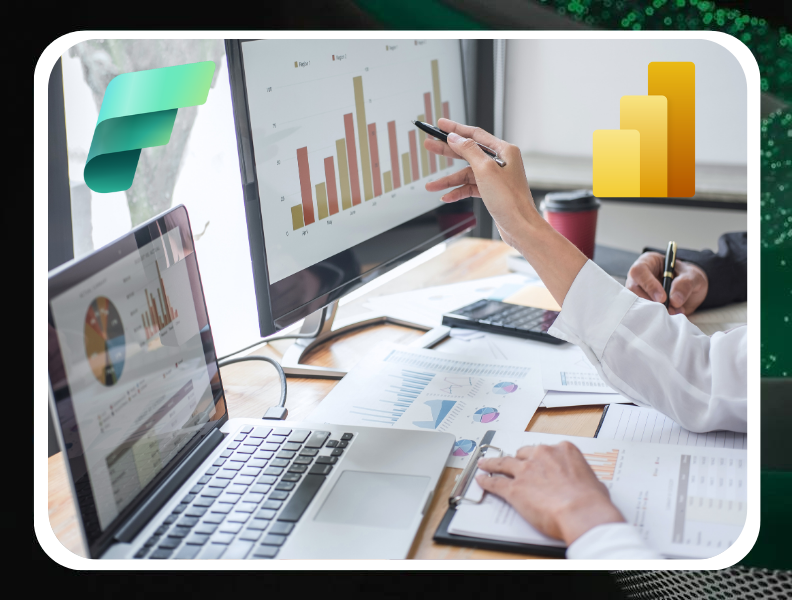
Have you ever wondered how important access to up-to-date business data really is? In today’s fast-paced market environment, every decision must be based on reliable and current information. Real-time reporting offers just that — allowing you to track key indicators and performance almost instantly, without unnecessary delays.
So, what exactly is real-time reporting? It’s a process in which data is collected, processed, and presented continuously, enabling users to make decisions based on the most recent information. That means you don’t have to wait for monthly or weekly reports that may already be outdated — instead, you get a full view of your business exactly when you need it.
What is real-time reporting?
Real-time reporting is a method of data presentation that allows for minute-by-minute monitoring. Instead of processing data once per day, week, or month, Business Intelligence (BI) systems collect and update information continuously, enabling decisions based on the freshest data available.
Static vs. real-time reporting
Traditional, or static, reporting is based on delayed data processing. For many companies, this means making decisions using information from several days — or even weeks — ago. Data is first collected, then processed, and finally presented in a report. It’s a time-consuming process that may not be enough in a fast-changing business environment.
Real-time reporting, on the other hand, works entirely differently. Data from source systems (ERP, CRM, e-commerce, Excel, Google Analytics, social media, and others) is automatically updated and displayed to users almost instantly. This ensures that what you see on your dashboard isn’t a “story from yesterday” — it’s the current business situation, right now.
Use cases for real-time reporting
Real-time reporting is useful across almost every industry. Here are a few concrete examples:
- Sales – Monitoring sales performance in real time allows managers to react immediately to dips or spikes in sales. For instance, if a marketing campaign triggers a spike in transactions, you can instantly increase the ad budget or launch a promotion.
- Manufacturing – On-the-fly reports help monitor production line efficiency, machine downtimes, raw material usage, or product quality. Any anomalies are visible right away — before they turn into costly issues.
- Logistics – With real-time data on stock levels, shipment statuses, or courier routes, you can manage the supply chain more efficiently. For example, if the BI system reports a delayed dispatch, you can notify the client before they ask.
- Marketing – Real-time reporting lets you analyze campaign performance instantly. You can quickly spot which channels deliver the best return on investment (ROI) and which need adjustment.
In all these scenarios, the common denominator is clear: faster reaction = better business decisions. That’s why more companies are turning to tools like Power BI and Microsoft Fabric, which allow you to create automated, live reports and provide 24/7 access to data — even on your smartphone.
Why implement real-time reporting?
In a world where the market landscape can shift within hours, real-time reporting becomes a competitive advantage. Why don’t companies that adopt it want to go back to manually created reports?
Faster decision-making
There’s no need to wait for an analyst to prepare a report or to export data from Excel. Executives, managers, and operational teams get instant access to up-to-date data, enabling timely and accurate decisions — not a day later when the situation may already be different.
Immediate response to deviations and anomalies
Noticed a sudden drop in product sales? Or a budget overrun in a marketing campaign? With real-time reporting, you can act immediately — before a minor issue turns into a significant business problem.
More transparency and control over processes
Live dashboards make it possible to track operational indicators in real time, which boosts process transparency and helps quickly identify bottlenecks, delays, or communication breakdowns between departments.
Improved collaboration across teams
When everyone is working from the same, up-to-date data, there’s no more confusion over “version mismatches” in Excel. Sales, marketing, finance, and production teams share a common point of reference — an interactive BI dashboard that can be commented on, filtered, and jointly analyzed.
24/7 access to data from any device
Both Power BI and Microsoft Fabric provide dashboard access from your computer, tablet, or smartphone. Data is available around the clock, which is especially crucial for companies operating internationally or managing shift-based production.
How does real-time reporting work in Power BI and Microsoft Fabric?
Real-time reporting isn’t magic — it’s the result of a well-designed data infrastructure and the use of appropriate tools. Microsoft Power BI and Microsoft Fabric allow you to build a reporting system that operates continuously and responds to data changes in real time.
Integration with multiple data sources
BI systems integrate data from various sources: ERP systems (e.g., SAP, Dynamics), accounting tools, Excel, CRM systems (e.g., Salesforce), data warehouses, marketing automation platforms, or cloud storage (e.g., Azure, Google Cloud, AWS). This gives you a comprehensive view of your business, no matter where your data is stored.
Real-time data updates
Power BI enables mechanisms such as:
- DirectQuery – Data is pulled directly from the source system without copying it.
- Streaming data – Data flows into the report immediately upon being generated (e.g., real-time sales system updates).
- Automatic dataset refresh – Scheduled refreshes can update data as frequently as every 15 minutes or hour.
This way, users don’t see “yesterday’s data,” but exactly what’s happening in the business right now.
Example of a live sales dashboard in Power BI
Imagine a sales dashboard where you can track in real time:
- Number of orders by region and sales channel
- Progress toward monthly targets
- Products with the highest revenue share
- Current online advertising campaign costs
Thanks to DirectQuery, data from your CRM and Google Ads updates in real time — giving you a complete picture of your sales and marketing performance without needing to hit “refresh.”
Challenges and best practices
Implementing real-time reporting is a major step toward modern data management. But like any IT project, it comes with specific challenges. A well-thought-out strategy, robust data architecture, and trained team can make or break the implementation.
Common challenges
- System performance
When dashboards pull live data from multiple sources (ERP, CRM, Excel, data warehouses), there’s a risk of slowing down performance — especially with DirectQuery, where every filter click triggers a database query. That’s why optimizing queries and data structures is crucial.
- Data integration from different systems
Combining data from different systems — often in various formats and without shared identifiers — can be difficult. Inconsistencies can lead to inaccurate insights. A solid ETL (Extract, Transform, Load) process and data standardization are key.
- Data quality
A real-time report is only as good as the data it contains. If your source data includes errors, duplicates, missing values, or outdated records, your dashboards will mislead. Implementing data quality procedures and validation mechanisms is essential.
Best practices for smart implementation
✅ Plan your data architecture
Before building dashboards, ask: Where will data come from and where will it go? Will it be streamed or periodically loaded? Will it need to be transformed along the way? Design a consistent data architecture using Microsoft Fabric, Dataflows, Lakehouse, and Power BI to avoid future chaos and downtime.
✅ Optimize your data sources
Whether you use Excel, Dynamics, SAP, SQL Server, or marketing systems — make sure they’re optimized for performance. This includes indexing, minimizing columns and rows, and pre-filtering data before loading it. Your Power BI dashboards will be smoother and faster.
✅ Maintaining security and access control
Real-time reporting often involves access to sensitive data — whether it’s financial records, personal information, or operational details. That’s why it’s essential to implement Row-Level Security (RLS) in Power BI, which restricts access to data based on the user’s role. Equally important is defining clear data access policies, ensuring that employees only see the information they are authorized to view.
A recommended best practice is to leverage Azure Active Directory to manage user identities and permissions, and to monitor activity logs to detect any suspicious behavior or misuse. These measures not only enhance security but also build trust within the organization by protecting critical business data.
✅ Educating your team
Implementing new technology isn’t enough — your team needs to know how to use it effectively. Training employees to navigate Power BI, interpret dashboards, and understand the meaning behind key business metrics is a strategic investment that quickly pays off.
It’s equally important to promote a strong data culture within your organization. This means encouraging employees at all levels to make decisions based on data, not just intuition. When everyone speaks the “language of data,” collaboration improves, discussions become more objective, and results are more measurable.
What are the benefits of real-time reporting?
Real-time reporting is no longer a luxury reserved for global corporations. It’s a practical and accessible solution for any company that wants to make better-informed decisions and react faster to market changes.
Let’s revisit the most significant benefits:
- 24/7 access to current data — available on both computers and mobile devices
- Faster decision-making through dynamic, always-up-to-date dashboards
- Automatic detection of deviations and irregularities in data
- Improved collaboration across departments, thanks to shared, real-time insights
- Greater process transparency in sales, logistics, production, and marketing
Now consider how reporting looks in your organization today. Are reports still generated manually? Do you sometimes wait hours — or even days — to receive critical data? If so, now might be the perfect time to take a step forward.
Implementing live reporting with Power BI and Microsoft Fabric doesn’t have to be complicated. The key is choosing the right partner — one who understands both the technical landscape and your real business needs.
Want to see what real-time reporting could look like in your company?
Experience it for yourself — whether it’s a sales dashboard updating every second, or a production report integrated with your ERP system, real-time insights can transform how your organization operates.
👉 Contact us — our experts will analyze your current reporting system and recommend practical improvements.
👉 Or join a Microsoft Power BI and Fabric training session, where we guide you step by step on how to effectively use these tools in real business scenarios.
🔗 Book a free consultation
🔗 Sign up for a training session
Don’t wait for the Monday morning report. Switch to real-time data and make decisions exactly when they matter most.



